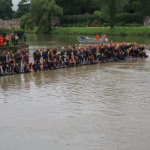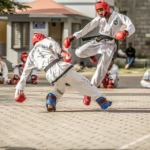Echoes of the Illyrians: The Cultural Heritage of Kosovo
Introduction
Kosovo, a land steeped in ancient history, is a cultural mosaic characterized by its diverse heritage. At the heart of this legacy lie the Illyrians, an ancient group of tribes known to have inhabited the western Balkans, including present-day Kosovo, from antiquity until the Roman conquest. The echoes of the Illyrians resonate through modern Kosovo, influencing its language, traditions, and cultural practices. This article journeys through the multifaceted cultural heritage of Kosovo, exploring the Illyrian roots and their lasting influence on contemporary society.
The Illyrians: A Brief Historical Context
The Illyrians were a group of tribes that occupied the western Balkans, with their territory encompassing what is now Kosovo, Albania, Montenegro, and parts of Croatia and Bosnia. Historians suggest that the Illyrians existed as a distinct cultural group from at least the 2nd millennium BC. Their lifestyle was primarily agrarian, supplemented by pastoralism, hunting, and gathering. Archaeological findings, including burial mounds, pottery, and weapons, indicate a rich cultural tapestry marked by tribal solidarity and early forms of governance.
The first recorded mention of the Illyrians came from ancient Greek authors such as Herodotus and later, by Roman historians. They described a society that was both fierce in battle and rich in customs. The Illyrians were not monolithic; rather, they were composed of various tribes, each with its own customs and dialects, variations that sowed the seeds for Kosovo’s rich cultural diversity.
Archaeological Legacy
The archaeological record in Kosovo is a testament to its Illyrian past. Numerous sites, such as the Great Kosovo Plain and the ancient city of Ulpiana, reveal remnants of Illyrian settlements. Excavations have unearthed artifacts ranging from intricately designed pottery to weaponry that elucidates both the aesthetic and functional aspects of Illyrian life.
Important Sites
-
Ulpiana: Once a flourishing city during the Roman Empire, Ulpiana has revealed significant findings, including the remains of temples, public baths, and housing structures. Notably, the site showcases a blend of Illyrian and Roman influences, demonstrating the cultural exchange that occurred during and after the Roman conquest.
-
Tumulus of Perçan: This burial mound is one of the most important Illyrian sites in Kosovo. Its excavation led to the discovery of grave goods, including weapons and jewelry, highlighting the social status of the buried individuals and the funerary practices of the time.
- The Fortress of Novak: Locally known as the "Fortress of the Illyrians," this site embodies the military prowess and strategic importance of the Illyrian tribes. It serves as a symbol of resistance against Roman expansion and reflects the martial tradition carried through generations.
Language and Oral Tradition
The Illyrians left a linguistic legacy that continues to influence the Albanian language, which is considered the descendant of the ancient Illyrian tongue. While the exact relationship between Illyrian and modern Albanian remains a topic of scholarly debate, certain elements of vocabulary and syntax suggest a connection.
Moreover, oral traditions and folklore in Kosovo are imbued with Illyrian elements, embedded in songs, tales, and proverbs passed down through generations. These narratives encapsulate themes of heroism, nature, and ancestral pride, affirming a collective identity that resonates with the spirit of the Illyrians.
Folklore and Mythology
Numerous folk tales and legends rooted in the Illyrian past continue to thrive in Kosovo’s cultural narrative. These stories often feature mythical beings and heroes, reminiscent of the Illyrian pantheon. The celebration of cultural festivals serves as an avenue for the preservation and promotion of these traditions, thereby maintaining the Illyrian spirit.
Religious Practices
The religious landscape in Kosovo reflects a syncretism uniquely shaped by Illyrian beliefs, Christianity, and Islam. The Illyrians practiced polytheism, venerating a pantheon of gods associated with natural elements, fertility, and war. While much of their religious practices has been lost, some remnants may still be found in local customs and superstitions.
Festivals
Cultural festivals in Kosovo often feature rituals and practices that echo Illyrian traditions. For instance, celebrations during springtime frequently acknowledge fertility rites, which have roots deep in Illyrian agricultural practices. Furthermore, the customs surrounding weddings and harvests display a blend of ancient Illyrian and contemporary influences, particularly in the adornments and songs performed.
Music and Dance
Music is an integral aspect of Kosovo’s cultural heritage, with ancient roots linked to the Illyrians. Traditional instruments, such as the çiftelia (a two-stringed lute) and lahuta (a one-stringed instrument), produce melodies that resonate with the rhythms of Illyrian life.
Illyrian Influence on Contemporary Music
The influence of Illyrian music can be observed in modern Kosovo’s folk genre, where traditional melodies intertwine with contemporary sounds. Performers often revive ancient Illyrian songs, infusing them with modern arrangements that appeal to younger generations while preserving the essence of their origins.
Dance, too, serves as a cultural conduit. Traditional dances often reflect Illyrian themes of community, unity, and celebration. The kercova and trojet dances are vibrant expressions of this legacy, performed during festivals and communal gatherings.
The Arts
The arts in Kosovo have an enduring connection to its ancient past. Visual arts—ranging from paintings and crafts to sculpture—frequently incorporate Illyrian motifs. Artists draw inspiration from the Illyrian symbols found in archaeological artifacts, expressing them through contemporary mediums.
Craftsmanship
In particular, the craftsmanship of traditional textiles and ceramic arts has roots in Illyrian techniques. Pottery styles, often adorned with geometric patterns, showcase continuity from ancient times to the present. Contemporary artisans have revived these traditional techniques, ensuring that Illyrian artistry continues to flourish.
The Influence on National Identity
Kosovo’s national identity is inextricably linked to its Illyrian heritage. After years of political turmoil and conflict, there has been a renewed emphasis on reconnecting with Kosovo’s historical roots. The symbol of the Illyrian Albanian, represented by the double-headed eagle, serves as a powerful emblem of national pride and unity.
The Role of Education
Efforts to preserve and promote Illyrian heritage have flourished within educational frameworks. Schools in Kosovo incorporate courses that focus on the history and culture of the Illyrians, fostering a sense of pride and identity among younger generations. Knowledge of their ancestry encourages a greater appreciation for cultural diversity, melding ancient traditions with modern values.
Contemporary Challenges
Despite the rich cultural heritage, Kosovo faces challenges in preserving and promoting its Illyrian legacy amidst globalization. The influence of modernity sometimes threatens to overshadow traditional practices and values. However, initiatives aimed at safeguarding cultural heritage are increasingly prevalent, with NGOs and community groups actively working to maintain and revive Illyrian traditions.
Conclusion
The cultural heritage of Kosovo, deeply rooted in its Illyrian past, reflects a rich tapestry woven through history, language, and tradition. The echoes of the Illyrians resonate in the customs, music, and arts that define Kosovo’s identity today. As the country continues to evolve within a modern global context, the preservation of its ancient heritage will play a vital role in shaping a future that honors its history while embracing diversity. Recognizing and celebrating the Illyrian legacy can foster unity among Kosovo’s diverse populations, affirming the nation’s place on the cultural map of Europe.
References
Although unable to compile actual references, a comprehensive exploration of the topics discussed would undoubtedly involve consulting works by historians, archaeologists, and linguists involved in the study of the Illyrians and their influence on modern Balkan society. Suggested sources of interest include:
- Bennett, J. W. (2004). Illyrian and Roman Albania: A Historical Overview. Harvard University Press.
- Cabanes, P. (2010). The Illyrian World: A Cultural Heritage. Routledge.
- Palavestra, O. (2015). Kosovo: A Cultural Profile. University of Pristina Press.
Final Thoughts
The cultural heritage of Kosovo is not just a relic of the past; it is a living, breathing embodiment of a unique history that continues to shape the lives of its people today. Engaging with this heritage opens up a dialogue between past and present, allowing future generations to learn from the robust legacy of the Illyrians while crafting their own narratives in a rapidly changing world.


























Add Comment